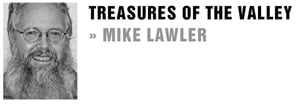
By Mike LAWLER
On the surface, Crescenta Valley Park is a big oak-shaded park, nestled in the southwest corner of our valley at the base of the Verdugo Mountain. But to many old timers, and to those up on their local history, it’s two distinct parks: CV Park to the east and Hindenberg to the west. The section of park on the west side of Dunsmore, including the big community center and parking lot, was, from well before WWII through the ‘50s, a privately owned picnic grounds with a very particular ethnic flavor.
Hindenberg Park, named for German President Paul Von Hindenberg, was owned by the German American League, and catered to the cultural needs of immigrants from Germany. Each weekend the park was filled with German performance troupes, Oompah bands, lots of drinking and dancing, and celebrations of anything and everything German. Attendance climbed to almost 10,000 on some weekends as people, either reliving their childhoods in their homeland or tracing their roots, streamed in from all over the southland. “Oktoberfest” was introduced there in 1956 when the German American League staged the first Oktoberfest in California, a tradition that lives on over 50 years later in Montrose’s annual celebration. The park gained a little infamy in the late ‘30s when the Nazi Party was the ruling power in Germany and the American arm of the Nazis, the Bund, staged rallies at Hindenberg Park, featuring giant swastikas and German military style uniforms. But that was a short lived and generally unwelcome presence at the park, which overall was a joyous location. The post-war population boom created a demand for more public parkland, and by 1956 the county was making cash offers on the 15 acres of Hindenberg that the German American League couldn’t refuse. In ’57 Hindenberg was folded into the larger CV Park.
Take a walk around old Hindenberg Park today, and you’ll still find foundations of the drink stands and stages that half a century later have been adapted for bases for picnic tables. The sharper eyes can pick out the former locations of the many German icons that graced the park, the Beethoven statue, and the 6 foot tall bust of President Hindenberg. The name Hindenberg Park still lives on in the vernacular of the older generation of CV residents, and for some odd reason, regional high-school cross country teams, who use the term “Hindenberg” for this part of their running courses.
Thankfully there has been an increase in a local awareness of the fascinating history of the park, and that awareness is about to take a giant leap, thanks to the efforts of local Boy Scout Wesley Shaler. He has chosen as his Eagle Scout project a series of plaques for the park that will explain its history to visitors. A bronze plaque mounted on a boulder will give a general overview while two large interpretive signs will feature photos of activities at old Hindenberg. The photos were donated by local resident and long-time Montrose Search and Rescue member Fred Keogler. His dad was the head organizer of activities at Hindenberg for several decades, and Fred literally grew up at the park.
Wesley has just begun the project of digesting the history of the park, and writing his proposed wording. I met with Wesley, his dad, and Scout Leader Rich Toyon at Hindenberg a week ago. I gave him a packet of historical material, some photos, and a brief tour to get him started, but it’s now up to him to get this very big ball rolling. He’ll have to do some reading, and study John Newcombe’s fascinating DVD “Rancho La Cañada: Then and Now” which has a great section on Hindenberg, including film footage of the celebrations (supplied again by Fred Keogler). He’ll talk to some old timers like Charles Bausback, who attended the celebrations at the park with his family back in the ‘30s, and retired CV High history teacher Gary Keyes, who has done a study of the Nazi activities at Hindenberg. (By the way, Gary was my history teacher at CV High, and I thank him for, or blame him for, much of my obsession with history.)
Perhaps the hardest part will be navigating the county’s requirements for the signs, but with CV Town Council President Steve Pierce to guide him, and the full support of County Parks Department and County Supervisor Mike Antonovich, he’ll have no major problems.
Look for these new signs in the spring of 2010 and I think they will add immensely to your enjoyment of one of the prettiest parks in CV. When we know the history of the land we live on, we feel much more invested in its future. Good luck to you Wesley, and thanks for the service you’re doing for our community
Mike Lawler is the president of the Historical Society of the Crescenta Valley.
